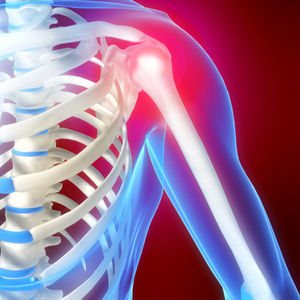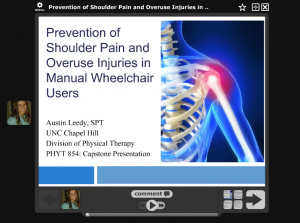Prevention of Shoulder Pain and Overuse Injuries in Manual Wheelchair Users
By Austin Leedy, SPT
Overview
In the United States, there are approximately 1.5 million manual wheelchair users and 70% of this population report experiencing shoulder pain making it the most common upper extremity joint pain reported among these individuals.2,3 Potential contributors to this shoulder pain are repetitive movements and forces needed for wheelchair propulsion and ADLs, chronic impingement syndromes, rotator cuff tears, shoulder joint complex muscle imbalances, adaption of poor posture, poor biomechanics during functional activities, and incorrect wheelchair parameters.3,4-7
Presence of shoulder pain in an individual who relies on a manual wheelchair as their primary mode of mobility can lead to decreased mobility, decreased functional activity, decreased ability to perform ADLs, decreased independence, and decreased quality of life. Furthermore, this also places individuals at increased risk of developing co-morbidities secondary to a sedentary lifestyle as was as an increased risk for hospitalization.3,5-8 Surgical intervention for these individuals is not optimal due to the need to remain non-weightbearing in the UE after surgery leading to the inability to be independent with daily care and mobility. This leads to conservative interventions being more realistic for this population.4
During my third clinical rotation in an inpatient rehabilitation setting, I treated many patients who were transitioning to manual wheelchair use after an acquired injury, or were chronic manual wheelchair users. Many individuals were motivated to prevent the development of shoulder pain or overuse injury in the future, or desired to improve their current pain. The purpose of this Capstone project is to synthesize the best evidence available in literature in order to create an effective home exercise program (HEP) and educational handout. The goal is to educate physical therapists and physical therapy students regarding implementation of the best evidence-based interventions, and provide manual wheelchair users with the educational tools to decrease pain and/or remain active without increasing his/her risk of shoulder pain/overuse injuries.
Research
The research for this project began in the fall of 2013 during our classes Evidence Based Practice II and Health and Wellness. In Evidence Based Practice II, I developed my original PICO question, “For adult traumatic complete spinal cord injury patients (levels T1-T12) how effective is an upper extremity exercise program compared to an upper extremity educational program for decreasing chronic shoulder pain and overuse injuries after 1 year post-injury?” An evidence table and a research paper were completed during this class. In Health and Wellness, I created a Health & Wellness Proposal consisting of a 12-week program including a shoulder education lecture, shoulder home exercise program (HEP), and a physical functional mobility course aimed at improving pain and decreasing overuse injuries in individuals with paraplegia.
At the conclusion of my research in fall 2013 and after receiving valuable feedback from my advisors, the decision was made to expand my population of interest from individuals with paraplegia to all individuals who use a manual wheelchair as their primary mode of mobility. The review of literature was expanded to include populations including all adult manual wheelchair users; therefore, an updated evidence table, Capstone Evidence Table, was created for the completion of my Capstone project.
Final Products
The target audience for my project is physical therapists and physical therapy students. All research was summarized into a Voicethread presentation with an associated Handout of the presentation in PDF form. The purpose of the Voicethread presentation is twofold: to provide education for multiple physical therapists working in inpatient and outpatient neuromuscular settings and to provide UNC DPT students with supplemental educational information during the neuromuscular assessment II course.
Additionally, resources for patients who are manual wheelchair users were created. A patient handout describing the Shoulder Home Exercise Program was created as well as a Patient Education Handout regarding strategies for decreasing risk of acquiring shoulder pain and overuse injuries or decreasing current shoulder pain and overuse injuries. This will not only help patients achieve the aforementioned goals, but is also aimed at providing patients with the tools to promote self-efficacy by educating them how the program/techniques can be applied to his/her daily routine.
Evaluation
An anonymous 10-question feedback survey was sent to physical therapists and physical therapy students via Surveymonkey.com: https://www.surveymonkey.com/s/RT2DBMJ. A PDF form of the Capstone Feedback Survey can be seen here as well as a PDF of the Capstone Feedback Survey Results. Overall, physical therapists and physical therapy students consider the prevention of shoulder pain and overuse injuries in manual wheelchair users to be an important topic of understanding when treating a patient who is a manual wheelchair user. Most survey respondents did not feel comfortable creating an exercise program for individuals who are manual wheelchair users prior to viewing the presentation, and one physical therapist and one physical therapy student reported feeling comfortable. Most importantly, all 14 respondents (2 physical therapists and 12 physical therapy students) felt the presentation and handouts were effective and reported feeling more comfortable with creating a plan of care for a patient who as a manual wheelchair user after viewing the materials.
After receiving areas for improvement as well as performing a self-assessment in the future, I will work towards condensing the Voicethread presentation to decrease the length of the presentation. Furthermore, many respondents suggested the addition of more information regarding the affects of wheelchair adjustments, modifications and ergonomic use. I am in agreement with the survey respondents and am also interested in expanding my research to include more information regarding the effects of wheelchair prescription and modification, and how this affects other factors such as propulsion technique/ergonomics, etc. Finally, in the future I plan on creating my own pictures to clarify form of the exercises and improve comprehension of ways in which the exercises can be modified.
A Special Thanks
I would like to thank my advisor, Mike Gross, and my committee members Mary Beth Osborne and Courtney Matrunick for their guidance. Additionally, I would like to thank every physical therapist and physical therapy student who took the time to provide me with valuable feedback on my presentation materials. Please feel free to contact me at Austin_Leedy@med.unc.edu for any comments or questions, or feel free to comment below! Thank you for visiting my page! This is a topic I am truly passionate about and I hope to continue this project in the future as a licensed physical therapist!
References:
- Page, A. Health Central. 12 Advances in Bionics. Health Central Website: http://www.healthcentral.com/depression/cf/slideshows/12-advances-in-bionics May 30, 2012. Accessed April 14, 2014.
- Wessels KK, Brown JL, Ebersole KT, Sosnoff JJ. Sex, shoulder pain, and range of motion in manual wheelchair users. J Rehabil Res Dev. 2013;50(3):351-356.
- Moon Y, Jayaraman C, Hsu IM, Rice IM, Hsiao-Wecksler ET, Sosnoff JJ. Variability of peak shoulder force during wheelchair propulsion in manual wheelchair users with and without shoulder pain. Clin Biomech (Bristol, Avon). 2013;28(9-10):967-972. doi: 10.1016/j.clinbiomech.2013.10.004; 10.1016/j.clinbiomech.2013.10.004.
- Mulroy SJ, Thompson L, Kemp B, et al. Strengthening and optimal movements for painful shoulders (STOMPS) in chronic spinal cord injury: A randomized controlled trial. Phys Ther. 2011;91(3):305-324. doi: 10.2522/ptj.20100182; 10.2522/ptj.20100182
- O’Sullivan S, ed. Physical rehabilitation. 5th ed. FA Davis; 2007. O’Sullivan S. and Schmitz T., eds.
- Rice LA, Smith I, Kelleher AR, Greenwald K, Boninger ML. Impact of a wheelchair education protocol based on practice guidelines for preservation of upper limb function: A randomized trial. Arch Phys Med Rehabil. 2013. doi: 10.1016/j.apmr.2013.06.028; 10.1016/j.apmr.2013.06.028
- Curtis KA, Tyner TM, Zachary L, et al. Effect of a standard exercise protocol on shoulder pain in long-term wheelchair users. Spinal Cord. 1999;37(6):421-429.
- Nash MS, van de Ven I, van Elk N, Johnson BM. Effects of circuit resistance training on fitness attributes and upper-extremity pain in middle-aged men with paraplegia. Arch Phys Med Rehabil. 2007;88(1):70-75. doi: 10.1016/j.apmr.2006.10.003



5 Responses to “Prevention of Shoulder Pain and Overuse Injuries in Manual Wheelchair Users”
Mary Beth Osborne
Beautiful job with this, Austin! Your interest and commitment to the topic is evident in your work. Since this is a relatively new concept (last 15-20 years), people who sustained SCIs in the 80s and 90s may not be aware of this information. It might be useful to them to distribute your handouts to a SCI support group or offer to present at one of their meetings (in your spare time, of course :)). Nice job! Mary Beth
Austin Leedy
Thank you for your wonderful feedback everyone!
Daniel – Yes, I found two studies that implemented exercises similar to the ones I mentioned. Both studies used all three stretches I implemented and then each study had different strengthening exercises, but still targeted similar muscle groups; therefore, I combined the strengthening exercises and added the stretching exercises. I felt this would be best to not only provide the therapist with more exercises to attempt if one was not working, but also to provide more variety for the patient to improve compliance. Both studies were performed on adult individuals with paraplegia and demonstrated a high level of study quality. These were my references: Mulroy et al and Nawoczenski et al listed on my evidence table if you would like to read through them!
Mike – There is A LOT of ongoing research currently being conducted by researchers and wheelchair manufacturers in regards to improving design/parts in order to improve the efficiency of propulsion, thus decreasing forces/strain on the GH joint. Many of these studies focus on changes involving the tires of the wheelchair, the hand rim or push rim size/type, the weight of the wheelchair, and the set angles of the wheels and seat. Unfortunately, most manufacturer studies that involve testing patient populations are performed on athletes in wheelchairs or on a non-manual wheelchair users making it difficult to know what affects could be made on a manual wheelchair user with an average activity level. There is certainly a lot to learn in this arena and this is where I plan on expanding my project the most!
Michelle Green
Austin,
Such a great topic! Shoulder injuries can take away mobility for patients who rely on their UE for mobility with both a wheelchair and with assistive device. I have seen too often the wheelchair user who has a shulder injury, which results in difficulty with pressure relief and transfers which in turn, results in a pressure sore which ends up being much more difficult to heal than even the shoulder. It is a slippery slope and therapists awareness is critical during therapy sessions to ensure we are always HELPING mobility and not putting them in risky situations where the shoulder may be susceptible to overuse or injury. I have recommendations, it is a well presented topic.
Mike McMorris
Austin,
Great topic with an excellent presentation of materials. Your review of the topic’s relavence was a bit eye opening with such a high incidence of shoulder pain in people using manual wheelchairs. Enjoyed the voice thread as well as your proposal for the program. I wonder if wheelchair manufacturers have any suggestions or ongoing research to improve or change chair design in order to reduce shoulder stresses?
Well done!
Mike M
Daniel Blackmon
Great job, Austin! Prior to PT school I thought wheelchair users may be more susceptible to shoulder pain, as their movements to propel a wheelchair remind me of doing repetitive parallel bar dips. That much internal rotation and extension would have to predispose someone to injury!
I think this is a really important topic because of their reliance on their upper extremities for locomotion. Preserving this ability is of the utmost importance! Did you find any studies which implemented the shoulder program you recommended, and if so, how effective were they at reducing and/or preventing shoulder pain?
Nice job!
Daniel